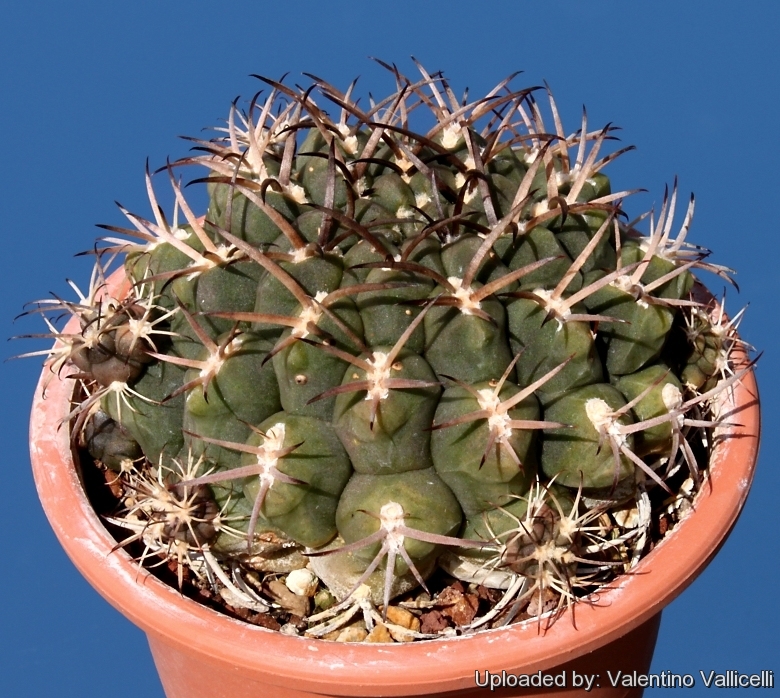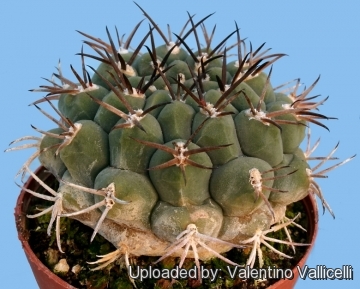
Gymnocalycium marsoneri Photo by: Valentino Vallicelli
Origin and Habitat: Widespread in Paraguay, south-western Brazil, southern Bolivia and northern Argentina.
Altitude: 700-1600 metres above sea level.
Synonyms:
See all synonyms of Gymnocalycium marsoneri
back
Accepted name in llifle Database:Gymnocalycium marsoneri Y.ItôExplan. Diagr. Austroechinocactinae 293 (1957)Synonymy: 12
Accepted name in llifle Database:Gymnocalycium marsoneri subs. matoense (Buining & Bredero) P.J.Braun & EstevesSucculenta (Netherlands) 74: 131. 1995Synonymy: 4
Cultivars
(1):
back
Description: Gymnocalycium marsoneriSN|13338]]SN|13338]] is a globular cactus, rather flattened, with spreading and sometimes recurved spines. They are a rich brown and form a pleasing contrast against the bronze-green body.
Habit: Solitary, barely rising above ground level, but often branching basally in cultivation to form clusters.
Stem Depressed-spherical, up to 7 cm tall (often more in cultivation) and up to 14 centimetres in diameter, dull greyish green, olive-green or dark-coppery red in full sun.
Ribs: 9-21, divided into tubercles
Tubercles: Large, prominent, rounded and spirally arranged.
Central spines: Usually absent.
Radial spines: 5-7 straight to slightly recurved, 2-3 cm long brownish above, lighter below at first, becoming darker with age.
Flowers: Campanulate to infundibuliform, 3-3,5 cm long and 3-4,5 cm in diameter, pale greenish white to white.
Fruit: Spherical to slightly ovoid, red, purple or bluish green.
Seeds: Nearly spherical pale brown. About 1 mm in diameter including the inconspicuous hilum.
Subspecies, varieties, forms and cultivars of plants belonging to the Gymnocalycium marsoneri group
 Gymnocalycium marsoneri Y.Itô: Widespread and variable. Distribution: Gran Chaco region of northern Argentina and southern Bolivia, Mato Grosso, Plateau of Brazil, and in Paraguay.
Gymnocalycium marsoneri Y.Itô: Widespread and variable. Distribution: Gran Chaco region of northern Argentina and southern Bolivia, Mato Grosso, Plateau of Brazil, and in Paraguay. Gymnocalycium marsoneri subs. matoense (Buining & Bredero) P.J.Braun & Esteves: has about 21 ribs and bluish green fruits. This is the Brazilian population of G. marsoneri. Distribution: Mato Grosso do Sul, border area to Uruguay.
Gymnocalycium marsoneri subs. matoense (Buining & Bredero) P.J.Braun & Esteves: has about 21 ribs and bluish green fruits. This is the Brazilian population of G. marsoneri. Distribution: Mato Grosso do Sul, border area to Uruguay. Gymnocalycium marsoneri subs. matoense cv. Multiproliferum hort.: this is a mutant that produces many suckers from the base and sides. Ribs 8-9 bright green; spines 4-7, thinner, bristle-like, yellowish-white or brownish, later grey.
Gymnocalycium marsoneri subs. matoense cv. Multiproliferum hort.: this is a mutant that produces many suckers from the base and sides. Ribs 8-9 bright green; spines 4-7, thinner, bristle-like, yellowish-white or brownish, later grey. Gymnocalycium marsoneri subs. megatae (Y.Itô) G.J.Charles: has a large flattened body with acute ribs, and 5 thin spines spreading from the body. Distribution: Bolivian Chaco, and Chaco Boreal (Paraguay), to Porto Murtinho, Mato Grosso do Sul (Brazil) where the Chaco becomes Pantanal.
Gymnocalycium marsoneri subs. megatae (Y.Itô) G.J.Charles: has a large flattened body with acute ribs, and 5 thin spines spreading from the body. Distribution: Bolivian Chaco, and Chaco Boreal (Paraguay), to Porto Murtinho, Mato Grosso do Sul (Brazil) where the Chaco becomes Pantanal.
Bibliography: Major references and further lectures
1) Edward Anderson “The Cactus family” Timber Press, Incorporated, 2001
2) James Cullen, Sabina G. Knees, H. Suzanne Cubey "The European Garden Flora Flowering Plants: A Manual for the Identification of Plants Cultivated in Europe, Both Out-of-Doors and Under Glass" Cambridge University Press, 11/Aug/2011
3) David R Hunt; Nigel P Taylor; Graham Charles; International Cactaceae Systematics Group. "The New Cactus Lexicon" dh books, 2006
4) Ito, Yoshi “Explanatory Diagram of Austroechinocactinae” 1957
5) Curt Backeberg “Die Cactaceae: Handbuch der Kakteenkunde” Gustav Fischer Verlag, Stuttgart New York 1982–1985
 Gymnocalycium marsoneri Photo by: Valentino Vallicelli
Gymnocalycium marsoneri Photo by: Valentino Vallicelli Gymnocalycium marsoneri Photo by: Valentino Vallicelli
Gymnocalycium marsoneri Photo by: Valentino VallicelliCultivation and Propagation: Gymnocalycium marsoneriSN|13338]]SN|13338]] is a summer grower species that is easy to cultivate.
Growth rate: It is a relatively rapidly growing and easily flowering species that will make clumps given the best conditions.
Soils: It likes very porous standard cactus mix soil. Prefer a low pH compost, avoid substrata rich in limestone; otherwise growth will stop altogether.
Repotting: This plant needs plenty of space for its roots, repotting should be done every other year or when the it has outgrown its pot. Use pot with good drainage.
Watering: Needs moderate to copious waterings in summer, but do not overwater (Rot prone), keep dry in winter at a minimum temperature of 0°C.
Fertilization: Feed with a high potassium fertilizer in summer.
Hardiness: Reputedly resistant to frost if kept on the dry side prior to, and during, cold weather (hardy to -5 C ° C, or less for short periods).
Exposition: The plant tolerates extremely bright situations but enjoys filtered sunlight or afternoon shade, inside it needs bright light, and some direct sun. Tends to bronze in strong light, which encourages flowering and heavy spine production, but is likely to suffer from sun scorch or stunted growth if over exposed to direct sunlight during the hottest part of the day in summer.
Uses: It is an excellent plant for container growing. It always looks good and stays small. It look fine in a cold greenhouse and frame or outdoor in a rockery.
Pests & diseases: It may be attractive to a variety of insects, but plants in good condition should be nearly pest-free, particularly if they are grown in a mineral potting-mix, with good exposure and ventilation. Nonetheless, there are several pests to watch for:
- Red spiders: Red spiders may be effectively rubbed up by watering the plants from above.
- Mealy bugs: Mealy bugs occasionally develop aerial into the new growth among the wool with disfiguring results, but the worst types develop underground on the roots and are invisible except by their effects.
- Scales: Scales are rarely a problem.
- Rot: This species is particularly easy and accommodating, seldom suffer of cryptogamic diseases. Rot it is only a minor problem with gymnocalyciums if the plants are watered and “aired” correctly. If they are not, fungicides won't help all that much.
Propagation: Division, direct sow after last frost. Seeds germinate in 7-14 days at 21-27° C in spring, remove gradually the glass cover as soon the plants will be well rooted (ca 1-2 weeks) and keep ventilated, no full sun for young plants! To make a cutting twist off a branch and permit it to dry out a couple of weeks, lay it on the soil and insert the stem end partially into the soil. Try to keep the cutting somewhat upright so that the roots are able to grow downward.












